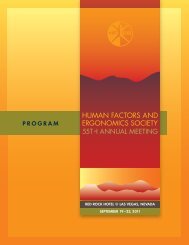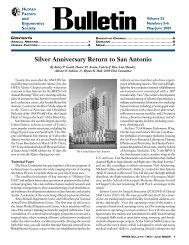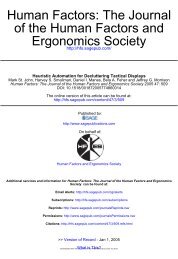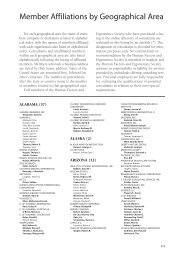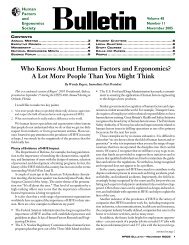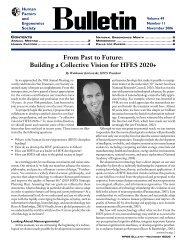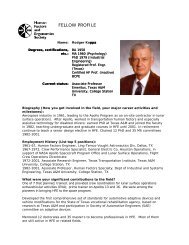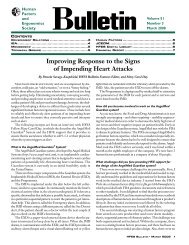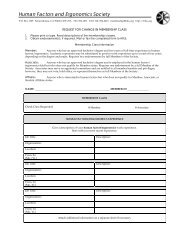Next Generation Air Transportation System Integrated Plan
Next Generation Air Transportation System Integrated Plan
Next Generation Air Transportation System Integrated Plan
Create successful ePaper yourself
Turn your PDF publications into a flip-book with our unique Google optimized e-Paper software.
to their highest and best use. This roadmap in no way implies that<br />
government can solve all the problems facing aviation. The goal is not<br />
to create an industrial policy by which the government tries to pick<br />
winning technologies, but instead to provide a framework to utilize<br />
the creative forces of the market. Market forces should play a role<br />
wherever possible.<br />
Sparked by this leadership, these agencies, working closely with the<br />
private sector, have defined eight strategies for transformation, each<br />
individually significant yet interdependent on the other seven. The<br />
eight strategies are the first steps toward a roadmap to provide a<br />
credible and stable path forward. As the term implies, this roadmap<br />
can guide our efforts to arrive at our destination if the paths and<br />
connections are clearly identified. With this roadmap, both public<br />
and private sectors can develop long-term investment plans and<br />
activities that result in the <strong>Next</strong> <strong>Generation</strong> <strong>Air</strong> <strong>Transportation</strong> <strong>System</strong>.<br />
Since local governments and the private sector represent the majority<br />
of owners and investors in the air transportation infrastructure and<br />
its operations, their active participation is essential. Using one of<br />
industry’s best practices, the integrated product team (IPT), each<br />
of the eight transformation strategies will be researched, developed,<br />
implemented and maintained through its own IPT. The power of<br />
the IPT model centers on the involvement of all parties touched by a<br />
process. In this way, each strategy team will be led by an agency with<br />
the charge to integrate across the interests of federal, state and local<br />
governments, quasi-government research institutions, universities,<br />
and most importantly, the manufacturers, service industries, and<br />
customers of the air transportation system. Recognizing that the<br />
United States has the most creative, innovative and successful<br />
industrial base in the world, government is striving to create a<br />
framework within which industry can excel.<br />
Achieving the vision of a transformed air transportation system<br />
requires us to open our minds to new possibilities, embrace new<br />
approaches and create new ways to work together. To secure America’s<br />
place as a global leader in aviation’s second century, we need an air<br />
transportation system that supports a strong commercial capability,<br />
facilitates private-sector expansion, and creates jobs. For that purpose<br />
our strategies are centered on:<br />
set of security layers will deliver security without creating undue<br />
delays, limiting access, or adding excessive costs and time.<br />
• Creating a responsive air traffic system by devising alternative<br />
concepts of airspace and airport operations to serve present and<br />
future aircraft. As new vehicle classes and business models emerge,<br />
such as remotely operated vehicles and spaceports, the safe and<br />
efficient operation of all vehicles in the National <strong>Air</strong>space <strong>System</strong><br />
will be critical to creating new markets in aviation and beyond.<br />
• Providing each traveler and operator in the system with the specific<br />
situational awareness they need to reach decisions through the<br />
creation of a combined information network. All users of the system<br />
will have access to the air transportation system data they require for<br />
their operations.<br />
• Managing safety through a comprehensive and proactive approach<br />
that can integrate major changes, such as new technologies or<br />
procedures. This will be done in a timely manner and without<br />
compromising aviation’s current superior safety record.<br />
• Introducing new policies, operational procedures, and technologies<br />
to minimize the impact of noise and emissions on the environment<br />
and eliminate ground contaminants at airports. This effort includes<br />
exploration of alternative fuels, engine and aircraft designs. These<br />
actions will result in reduced environmental impact and sustained<br />
aviation growth.<br />
• Reducing the impact of weather on air travel through a systemwide<br />
capability for enhanced weather observations and forecasts,<br />
integrating them with the tools used by air system operators. This<br />
capability will substantially improve airspace capacity and efficiency<br />
while enhancing safety.<br />
• Harmonizing equipage and operations globally by developing<br />
and employing uniform standards, procedures, and air and space<br />
transportation policies worldwide, enhancing safety and efficiency<br />
on a global scale.<br />
There has never been a transformation effort similar to this one with<br />
as many stakeholders and as broad in scope. The objective of this plan<br />
is to provide the opportunity for creative solutions for the future of<br />
air transportation, our security and our hope for a vibrant future.<br />
• Developing the airport infrastructure to meet future demand by<br />
empowering local communities and regions to create alternative<br />
concepts of how airports will be used and managed in the future.<br />
• Establishing an effective security system without limiting mobility<br />
or civil liberties by embedding security measures throughout the air<br />
transportation system – from curb to curb. Creating a transparent<br />
Joint <strong>Plan</strong>ning & Development Office<br />
ii



